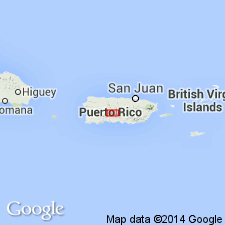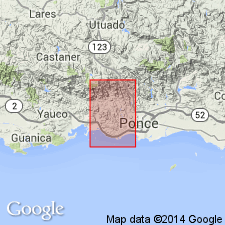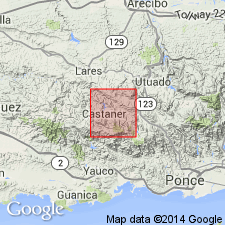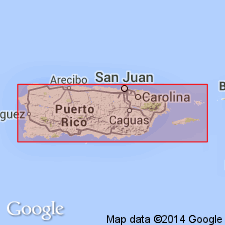
- Usage in publication:
-
- Lago Garzas Formation*
- Modifications:
-
- Named
- Dominant lithology:
-
- Mudstone
- Sandstone
- Tuff
- Lava
- AAPG geologic province:
-
- Caribbean region
Summary:
The Lago Garzas Formation, here named, consists of intertonguing basal epiclastic mudstone and volcanic sandstone member, middle pyroclastic tuff member, and upper lava member. Is part of a broad band of rocks exposed from Ponce to the west coast, divided into a northern zone of rocks correlative with the Anon Formation and a southern zone that contains several units, one of which is the Lago Garzas. All contacts of the Lago Garzas are faults. Minimum thickness is 1,700 m. Age is at least part Late Cretaceous (Maastrichtian) but may extend older or younger.
Source: GNU records (USGS DDS-6; Reston GNULEX).

- Usage in publication:
-
- Lago Garzas Formation*
- Modifications:
-
- Revised
- AAPG geologic province:
-
- Caribbean region
Summary:
The Lago Garzas in the Penuelas quadrangle is here revised and the Pastillo and Santas Pascuas Members are named. The Rio Blanco Formation is abandoned because the interbedded sequence of Cretaceous and Tertiary rocks mapped as Rio Blanco in the Penuelas quadrangle includes lithofacies of the Yauco and Lago Garzas Formations which are sufficiently different to map separately in most areas. Age is Campanian(?) and Maastrichtian.
Source: GNU records (USGS DDS-6; Reston GNULEX).

- Usage in publication:
-
- Lago Garzas Formation*
- Modifications:
-
- Revised
- Age modified
- AAPG geologic province:
-
- Caribbean region
Summary:
Interbedded lithofacies of the Anon and Lago Garzas are not given separate formation names. Therefore the Santas Pascuas Member of the Lago Garzas is abandoned and considered to be a lithofacies of the Anon. The Mal Paso and Palma Escrita Formations are abandoned and are considered to be interbedded facies of the Anon and Lago Garzas. The Pastillo Member of the Lago Garzas is retained. It consists of dark-red-purple-brown augite andesite lava and breccia. Age is Late Cretaceous (Campanian, Maastrichtian) through Eocene(?).
Source: GNU records (USGS DDS-6; Reston GNULEX).

- Usage in publication:
-
- Lago Garzas Formation*
- Modifications:
-
- Overview
- AAPG geologic province:
-
- Caribbean region
Summary:
The Lago Garzas Formation occurs in southwestern Puerto Rico and consists of dark-red volcanic breccia, lava, and subordinate volcanic sandstone and claystone, calcirudite, and pillowed basalt flows. Maximum estimated thickness is 1000 meters. The Lago Garzas is of Late Cretaceous to Eocene age.
Source: GNU records (USGS DDS-6; Reston GNULEX).
For more information, please contact Nancy Stamm, Geologic Names Committee Secretary.
Asterisk (*) indicates published by U.S. Geological Survey authors.
"No current usage" (†) implies that a name has been abandoned or has fallen into disuse. Former usage and, if known, replacement name given in parentheses ( ).
Slash (/) indicates name conflicts with nomenclatural guidelines (CSN, 1933; ACSN, 1961, 1970; NACSN, 1983, 2005, 2021). May be explained within brackets ([ ]).

